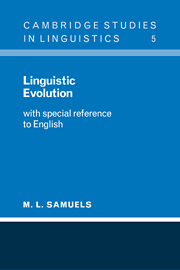Book contents
- Frontmatter
- Contents
- Preface
- Note to second impression
- Abbreviations
- 1 Introduction
- 2 Variation in the spoken chain
- 3 System: the phoneme
- 4 Grammar and lexis (I): variation
- 5 Grammar and lexis (II): systemic regulation
- 6 Diversity and contact
- 7 An assessment of the problem
- 8 Dimensions of study
- 9 Conclusions
- Bibliography
- Index of persons
- Index of subjects
- Plate section
2 - Variation in the spoken chain
Published online by Cambridge University Press: 05 June 2012
- Frontmatter
- Contents
- Preface
- Note to second impression
- Abbreviations
- 1 Introduction
- 2 Variation in the spoken chain
- 3 System: the phoneme
- 4 Grammar and lexis (I): variation
- 5 Grammar and lexis (II): systemic regulation
- 6 Diversity and contact
- 7 An assessment of the problem
- 8 Dimensions of study
- 9 Conclusions
- Bibliography
- Index of persons
- Index of subjects
- Plate section
Summary
Introductory
Human language is extremely highly developed compared with that of animals, and indeed it is probably the main reason for the development of the human brain; but that does not mean that it is mechanically the best and most efficient means of communication that could be devised. The arbitrariness of its chosen combinations of sounds, the necessity of producing them consecutively with organs that were not originally evolved for the purpose, the fluidity of the word-concept spectrum – these are all typical disadvantages that might be held to support the old popular idea that languages naturally ‘degenerate’. But that is now outdated, and it is recognised that all types of language are equally valid as communication, provided that they are used in their appropriate place or social milieu (dialects), or for the appropriate purpose (registers: cf. 6.2). The modern view carries with it the assumption that, in any of these types of a language, potential breakdown in communication is constantly and automatically remedied. It follows that, in any investigation of linguistic change, the first question to be asked is: are linguistic changes purely mechanical in origin, arising from the very nature of the substance of the spoken chain? As has often been noted, success in performing acts of communication varies greatly, and, overall, comparatively few ‘bull's-eyes’ are scored. This is possible because (a) context and situation, and (b) the redundancy inherent in all linguistic systems, together provide a wide margin of tolerance for the understanding of actual, as distinct from ideal, utterances or writings.
- Type
- Chapter
- Information
- Linguistic EvolutionWith Special Reference to English, pp. 9 - 27Publisher: Cambridge University PressPrint publication year: 1972



